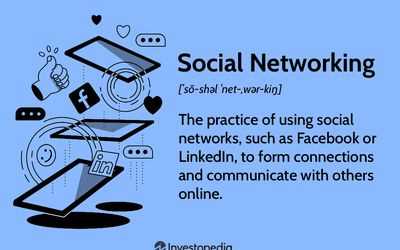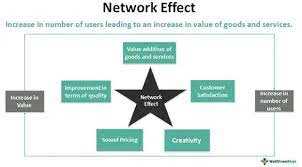The Power of the Network Effect
The network effect is a powerful phenomenon that occurs when the value of a product or service increases as more people use it. It is a concept that has been widely recognized and utilized in various industries, including technology, social media, and e-commerce.
At its core, the network effect relies on the idea that the more users a product or service has, the more valuable it becomes. This is because each additional user brings with them the potential for more connections, interactions, and benefits for all users involved.
One of the key reasons why the network effect is so powerful is that it creates a positive feedback loop. As more people join a network, the value of the network increases, which in turn attracts even more users. This cycle continues, leading to exponential growth and creating a self-reinforcing system.
Furthermore, the network effect can lead to increased user engagement and loyalty. When a product or service has a large user base, it becomes a central hub for communication, collaboration, and exchange of information. This fosters a sense of community and encourages users to stay connected and actively participate in the network.
Another aspect of the power of the network effect is its ability to drive innovation and create new opportunities. As more users join a network, there is a greater pool of resources, ideas, and expertise to draw from. This can lead to the development of new features, functionalities, and services that further enhance the value of the network.
However, it is important to note that the network effect is not without its challenges. One of the main drawbacks is the potential for monopolistic behavior. Once a network reaches a critical mass of users, it can become difficult for new entrants to compete, leading to a concentration of power in the hands of a few dominant players.
Additionally, the network effect can also create a barrier to entry for users who are not part of the network. If a product or service relies heavily on network effects, it may be difficult for new users to derive value from it until a certain threshold of users is reached.
Benefits of the Network Effect
1. Increased Value:
One of the main benefits of the network effect is that it increases the value of a product or service as more people join or use it. This is because the network effect creates a positive feedback loop where the more users there are, the more valuable the product or service becomes. For example, social media platforms like Facebook and Instagram become more valuable as more people join because it increases the opportunities for social interaction and content sharing.
Businesses that successfully leverage the network effect can gain a significant competitive advantage over their competitors. By building a large and active user base, these businesses create barriers to entry for new competitors. It becomes difficult for new entrants to attract users away from an established network with a strong network effect. This can lead to long-term sustainability and dominance in the market.
3. Cost Efficiency:
4. Network Effects as a Moat:
The network effect can act as a moat for businesses, protecting them from competition. Once a network effect is established, it becomes difficult for competitors to replicate or replace it. Users are often reluctant to switch to a new platform or service because they have already invested time and effort in building their network or because they value the network effect itself. This can create a loyal and sticky user base, making it challenging for competitors to gain traction.
5. Innovation and Collaboration:
The network effect fosters innovation and collaboration. As more users join a network, the opportunities for collaboration and knowledge sharing increase. This can lead to the development of new features, products, and services that benefit all users. For example, open-source software projects rely on the network effect to attract a community of developers who contribute to the project and improve its functionality over time.
Drawbacks of the Network Effect
The network effect, while powerful and beneficial in many ways, also comes with its fair share of drawbacks. It is important for businesses to be aware of these drawbacks and take them into consideration when leveraging the network effect in their marketing strategies.
- Dependency on network size: One of the main drawbacks of the network effect is that it requires a critical mass of users to be effective. Without a large enough network, the benefits of the network effect may not be fully realized. This can be a challenge for new businesses or those operating in niche markets.
- Difficulty in attracting users: Building a network can be a difficult and time-consuming process. Convincing users to join and actively participate in a network can be a challenge, especially if there are already established competitors with a larger user base. It requires a significant investment in marketing and user acquisition strategies.
- Risk of network saturation: Once a network reaches a certain size, it may become saturated with users and reach a point of diminishing returns. As more users join, the value of the network for each individual user may decrease. This can lead to user attrition and a decline in overall network effectiveness.
- Loss of control: When businesses rely heavily on the network effect, they may lose some control over their product or service. The network itself becomes a powerful entity that can influence user behavior and preferences. This loss of control can be challenging for businesses that want to maintain a certain level of autonomy.
- Network effects can be disrupted: The network effect is not immune to disruption. New technologies, changes in user preferences, or the emergence of new competitors can all disrupt the network effect and render it less effective. Businesses need to stay agile and adapt to these disruptions to maintain the benefits of the network effect.
How to Leverage the Network Effect

1. Build a Strong Network
The first step in leveraging the network effect is to build a strong network of users or customers. This can be done by offering a valuable product or service that attracts people to join or use your platform. It is important to focus on providing a seamless user experience and continuously improving your offering to keep users engaged.
2. Encourage Network Growth
To leverage the network effect, it is crucial to encourage network growth. This can be achieved by implementing referral programs, incentivizing users to invite others to join the network. Offering rewards or discounts for successful referrals can help attract new users and increase the overall network size.
3. Foster Network Effects

Once you have a strong network, it is important to foster network effects. This can be done by creating features or functionalities that enhance the value of the network as more users join. For example, social media platforms often introduce features like groups or events that encourage interaction and engagement among users.
4. Establish Network Effects as a Competitive Advantage
To leverage the network effect, it is essential to establish it as a competitive advantage. This can be done by highlighting the benefits of being part of a large network, such as access to a wider range of products or services, increased social connections, or better recommendations. Communicating these benefits effectively can help attract new users and retain existing ones.
5. Continuously Innovate
To maintain and leverage the network effect, it is important to continuously innovate. This can involve introducing new features, improving existing ones, and staying ahead of competitors. By constantly providing value to users, you can ensure that they remain engaged and continue to contribute to the network effect.

Emily Bibb simplifies finance through bestselling books and articles, bridging complex concepts for everyday understanding. Engaging audiences via social media, she shares insights for financial success. Active in seminars and philanthropy, Bibb aims to create a more financially informed society, driven by her passion for empowering others.
